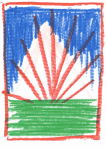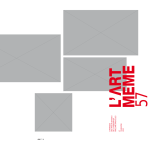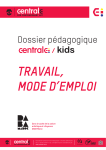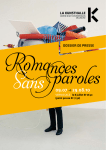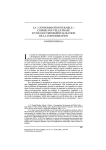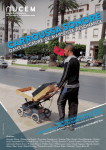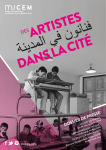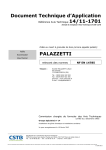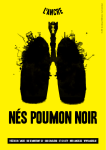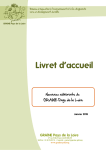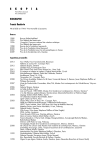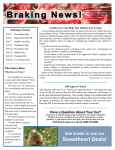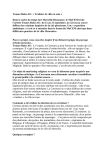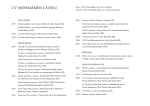Download younes baba-ali visual & sound artist
Transcript
younes baba-ali visual & sound artist eng. Younes Baba-Ali makes art that is unconventional, intelligent and critical, mostly in public space or places uncommon to art practice. He is a sharp observer and raises pertinent questions aimed at society, the institution and above all, his audience. As a free thinker he holds a mirror up to society and confronts it with its ingrained habits and dysfunctions. Baba-Ali’s work often assumes the form of the readymade, but underneath its facade of simplicity there is a complex exercise in balance at work. As an artist-alchemist he measures and mixes technology, objects, sound, video and photography with political, social and ecological issues. The resulting installations discreetly coerce the unsuspecting viewer into taking a stand. Baba-Ali shuns no controversy and often finds himself negotiating his art and its rationale with his environment. His works are context-specific and take their final form in dialogue with its spectators. This at times disruptive intervention art confronts the viewer in an ironical way with himself and his environment. Baba-Ali presents people dilemmas and taboos and challenges them to (re)act. In this way he makes them his accomplices in acts of artistic guerrilla that unite the establishment and the common man. Born in 1986 in Oujda (Ma), Younes Baba-Ali lives and works in Brussels (Be) & Casablanca (Ma). Graduating from l’Ecole Supérieure des Arts Décoratifs de Strasbourg in 2008, and from l’Ecole Supérieure d’Art d’Aix-en-Provence in 2011, he was rewarded by the prize “Léopold Sédar Senghor”, during the African Contemporary Art Biennial of Dakar (Sn) in 2012 and the prize “Boghossian”, during the Belgian Art Prize “Art’Contest” in Brussels (Be) in 2014. He has participated in several international exhibitions and biennials among them “Digital Africa: The Future is Now“, Southbank Centre, London (UK); “Strange Paradoxe”, MuCEM, Marseille (Fr); “Nass Belgica”, Botanique, Brussels (Be); “Where are we now?”, 5th Marrakech Biennial, Marrakech (Ma); “L’MAR9A”, Voice Gallery, Marrakech (Ma); “Travail, mode d’emploi”, Centrale for Contemporary Art, Brussels (Be); “Transaction Complete”, FaMa Gallery, Verona (It); “Dak’Art”, 10th African Contemporary Art Biennial, Dakar (Sn); “Regionale 12”, Haus für elektronische Künste, Basel (Ch); “Taverna Especial”, Sketch Gallery, London (Uk); “Brick & Mortar International Video Art Festival”, Greenfield (USA); “Loop” Video Art Festival, Barcelona (Es); “No Signal Found”, Arte Contemporanea Gallery, Brussels (Be); “Flowers, Animals, Urbans, Machines”, Appartement 22, Rabat (Ma) and “Desencuentros”, Sabrina Amrani Art Gallery, Madrid (Es). Cover : Untitled (megaphones), 2014 Exhibition view “Art’Contest” - Centrale for Contemporary Art, Brussels (Be) - © Younes Baba-Ali fr. nl. Younes Baba-Ali pratique un art non-conventionnel, intelligent et critique. Il travaille de préférence dans l’espace public ou dans des lieux peu communs. Fin observateur, il pose des questions pertinentes à la société, à l’institution, mais aussi surtout à son public. C’est un libre penseur, qui tend à la société un miroir et lui renvoie ses réflexes conditionnés et ses dysfonctionnements. L’œuvre de Baba-Ali se présente souvent sous la forme de ready-made, mais cette apparente simplicité dissimule un délicat exercice d’équilibre. À la manière d’un alchimiste, l’artiste dose et combine les techniques, les objets du quotidien, les sons, la vidéo et la photographie et adresse des questions politiques, sociales et écologiques. Les installations qu’il en distille poussent le spectateur à prendre position malgré lui. Baba-Ali ne recule pas devant la controverse et est même souvent contraint à de subtiles négociations avec son environnement pour revendiquer sa pratique artistique et son droit à l’existence. Son art est toujours spécifique à un contexte et ne prend vraiment sa forme que dans le dialogue du public. C’est de l’art d’intervention dérangeant et qui adopte parfois un ton ironique pour confronter le public à lui-même et à son environnement. Baba-Ali soumet au spectateur des dilemmes et des tabous et le défie d’agir et de réagir. Il en fait ainsi son complice dans une guérilla artistique clandestine qui réunit l’establishment et l’homme commun. Younes Baba-Ali maakt kunst die onconventioneel, intelligent en kritisch is, meestal in de openbare ruimte of op niet voor de hand liggende plaatsen. Hij is een scherp observator en stelt pertinente vragen aan de maatschappij, het instituut, maar ook en vooral aan zijn publiek. Als een vrijdenker houdt hij de samenleving een spiegel voor en legt zo haar vastgeroeste gewoontes en dysfuncties bloot. Baba-Ali’s werk presenteert zich vaak als readymade, maar onder deze ogenschijnlijke eenvoud schuilt een complexe evenwichtsoefening. Als een kunstenaar-alchemist doseert en combineert hij techniek, gebruiksvoorwerpen, geluid, video en fotografie met politieke, sociale en ecologische vraagstukken. De resulterende installaties bewegen de nietsvermoedende toeschouwer tot stellingname. Baba-Ali schuwt de controverse niet en wordt daardoor vaak gedwongen om zijn kunst en haar bestaansrecht subtiel te onderhandelen met zijn omgeving. Ze is steeds context-specifiek en krijgt pas haar echte vorm in dialoog met het publiek. Het is ontregelende interventiekunst, die op een soms ironische wijze de toeschouwer met zichzelf en zijn omgeving confronteert. Baba-Ali schotelt mensen dilemma’s en taboes voor en daagt hen uit tot (re)actie. Zo maakt hij hen tot zijn medeplichtigen in een verdoken artistieke guerrilla die zowel het establishment als de gewone man in de straat verenigt. Younes Baba-Ali, geboren in 1986 in Oujda (Ma), leeft en werkt in Brussel (Be) & Casablanca (Ma). Né en 1986 à Oujda (Ma), Younes Baba-Ali vit et travaille à Bruxelles (Be) et Casablanca (Ma). Diplômé de l’Ecole Supérieure des Arts Décoratifs de Strasbourg en 2008, et de l’Ecole Supérieure d’Art d’Aix-en-Provence en 2011, il a été récompensé par le prix “Léopold Sédar Senghor”, lors de la Biennale d’Art Contemporain Africain de Dakar (Sn) en 2012 et du prix “Boghossian”, lors du Concours d’Art Belge “Art’Contest” à Bruxelles (Be) en 2014. Il a participé à plusieurs expositions internationales et biennales, parmi lesquelles “Digital Africa: The Future is Now“, Southbank Centre, Londres (UK); “Strange Paradoxe”, MuCEM, Marseille (Fr); “Nass Belgica”, Botanique, Bruxelles (Be); “Where are we now?”, 5ème Biennale de Marrakech, Marrakech (Ma); “L’MAR9A”, Voice Gallery, Marrakech (Ma); “Travail, mode d’emploi”, Centrale for Contemporary Art, Bruxelles (Be); “Transaction Complete”, FaMa Gallery, Verone (It); “Dak’Art”, 10ème Biennale d’Art Contemporain Africain, Dakar (Sn); “Regionale 12”, Haus für elektronische Künste, Bâle (Ch); “Taverna Especial”, Sketch Gallery, Londres (Uk); “Brick & Mortar International Video Art Festival”, Greenfield (USA); “Loop” Festival d’Art Vidéo, Barcelone (Es); “No Signal Found”, Arte Contemporanea Gallery, Bruxelles (Be); “Flowers, Animals, Urbans, Machines”, Appartement 22, Rabat (Ma) and “Desencuentros”, Sabrina Amrani Art Gallery, Madrid (Es). Afgestudeerd van de Ecole Supérieure des Arts Décoratifs de Strasbourg (Fr) in 2008, en van de Ecole Supérieure d’Art d’Aix-en-Provence (Fr) in 2011, krijgt Younes Baba-Ali de prijs “Léopold Sédar Senghor” ter gelegenheid van de Afrikaanse Hedendaagse Kunst Biënnale van Dakar (Sn) in 2012 en de prijs “Boghossian” in het kader van de Belgische Kunstprijs “Art’Contest” in Brussel (BE) in 2014. Hij neemt deel aan verschillende internationale tentoonstellingen en biënnales waaronder “Digital Africa : The Future is Now”, Southbank Centre, London (UK); “Strange Paradoxe”, MuCEM, Marseille (Fr); “Nass Belgica”, Botanique, Brussel (Be); “Where are we now?”, 5de Marrakech Bienniale, Marrakech (Ma); “L’MAR9A”, Voice Gallery, Marrakech (Ma); “Travail, mode d’emploi”, Centrale voor Hedendaagse Kunst, Brussel (Be); “Transaction Complete”, FaMa Gallery, Verona (It); “Dak’Art”, 10de Afrikaanse Hedendaagse Kunst Biënnale van Dakar (Sn); “Regionale 12”, Haus für elektronische Künste, Basel (Ch); “Taverna Especial”, Sketch Gallery, London (UK); “Brick & Mortar International Video Art Festival”, Greenfield (USA); “Loop” Video Art Festival, Barcelona (Es); “No Signal Found”, Arte Contemporanea Gallery, Brussel (Be); “Flowers, Animals, Urbans, Machines”, Appartement 22, Rabat (Ma) en “Desencuentros”, Sabrina Amrani Art Gallery, Madrid (Es). younes baba-ali - art on the edge by kathleen weyts ”My art finds its rationale in the society it emerges from. That’s its ground and its subject. I function as a mediator, as a philosopher who shares a form of awareness with others. I measure the temperature of society and contribute to its interpretation and development.” Visual artist Younes Baba-Ali summarizes his artistic démarche in a nice way. He makes art that is unconventional, intelligent and critical, often in public space or places uncommon to art practice. He is a sharp observer and raises pertinent questions aimed at society, the institution and above all, his audience. As a free thinker he holds a mirror up to society and confronts it with its ingrained habits and dysfunctions. His art originates rarely in the atelier. It is context-specific and takes its final shape in dialogue with its spectators. Context Some of Baba-Ali’s works function almost exclusively in a specific environment. Moroccan Anthem for example, a video in which a donkey driver clucks out the Moroccan national anthem using the sound he normally makes to command his animal. Other installations get their meaning in relation to the place where they are shown. Like Ending your life under the sun, a coffin with a tanning bed inside it. The idea for this work emerged during his stay on the Erasmus exchange program in Poland, where people frequently visit tanning salons. Presenting the work at the 4th Marrakesh Biennial – where visitors were primarily Western – the installation was perceived as dealing with North-South migration; when it was exhibited in Europe however, the interpretation shifted more toward the idea of eternal beauty.” Art as intervention Ambiguity and humor are recurring elements in the work of this young artist. “I don’t want people to stay indifferent. I want to confront them and at the same time I want them to participate. I want to dispose art of its elitist and sacral status and to accomplish that I use certain strategies.” As an artist-alchemist he measures and mixes technology, objects, sound, video and photography with political, social and cultural issues. The resulting installations discreetly coerce the unsuspecting viewer into taking a stand. His work is constantly on the verge: it’s provocative, but never insulting or cheap, always inviting. It is the starting point for a conversation, a polemic, a thinking process, a (re)action. In a subtle way the artist plays the conventional social codes and at the same time the codes of art itself. Baba-Ali’s work often assumes the form of the readymade. He uses common objects and phenomena and introduces them in an artistic environment. But he prefers the public space to spaces intended for art. Making art accessible is almost a given in his oeuvre. In reaction to the extreme theorizing of art – where the audience is as it were assessed on its insider knowledge – and to the art institute that in the way it presents the artwork raises obstacles rather than remove them, he ingeniously intervenes in everyday life with his work. Carroussa Sonore is a beautiful example of this. A caroussa is a stroller with a sound system built on top, used for selling CD’s with Quranic recitals. A very common view in urban Maghreb streets, this object is a simple but extremely intelligent piece of technology. Baba-Ali uses it for his own purposes: “With Caroussa Sonore I bring sound pieces to people in a democratic way. It is both a creation and a medium I use as an art curator, since I invited other international artists to distribute their pieces via this module. It circles in the city, we built several interventions around it. In this way it becomes part of public life.” This intervention also denounces pertinent fallacies that circulate in the art world, such as the conviction that the Moroccan – and in extension Maghrebi – art scene limits itself to marketable objects. Baba-Ali proves the opposite by creating a platform for artists that are definitely active, but have difficulty in accessing the established European art scene - not in the least due to strict visa regulations. But as Baba-Ali puts it: “sound doesn’t need a visa, only a medium”. And rather than presenting his work to the establishment, he brings it to the people. This attitude is an implicit critique of both the art world and it’s critics. Baba-Ali addresses not just the art loving elite, but the people in the street. With this attitude he shows great affinity with artists such as Hassan Darsi and Francis Alÿs. Like them he makes disruptive intervention art that confronts the viewer – whether or not ironically – with himself and his environment. Baba-Ali presents people dilemmas and taboos and challenges them to (re)act. In this way he makes them his accomplices in a disguised artistic guerrilla that unites the establishment and the common man. Brussels Younes Baba-Ali was born in Oudja, Morocco but grew up and studied in France. Since 2011 he lives and works in Brussels. This double cultural background marks his life, his points of view and obviously his art. His affinity with both European and Maghrebi culture grants him the freedom to critically assess both worlds and to process this in his art practice. “As an artist I can afford to be critical. It’s my nature above all. Critique is a language that I learned to use. I raise questions and I want to involve the public. When observing Belgian society I notice that Moroccan immigration in France presents itself differently from that in Belgium. France is Morocco’s ‘big brother’, the ideal that Moroccan society and its elite try to attain. I observe the consequences of these phenomena and translate my findings into critical interventions.” An example of this is the installation Untitled (Speedbump) that he made for a group exhibition organised in a luxurious villa in the diplomatic district of Rabat. In that area – as in comparable wealthy areas in Morocco – huge speed bumps are installed. “To me this manipulation of urban space is very bourgeois and on top of that it’s immediately related to power. People in these quarters permit themselves to plump down speed bumps that are totally out of proportion. And so I decided to introduce these objects in their own living space, the bourgeois villa.” Baba-Ali does this fully aware that the audience that will visit the exhibition are the same people responsible for this phenomenon. By confronting them with it in the form of a work of art he also lends it a social dimension: “My interventions are to me also social, even political interventions that are coloured by their local context.” In the exhibition he developed for MAAC, Baba-Ali takes his personal relation to Brussels as a starting point. He confesses he has a love-hate relationship with this city, which he perceives as very complex. Brussels proves to be an ideal laboratory for the artist to develop his oeuvre. He presents works that are on the one hand representative of how he experiences the city as a French-Moroccan immigrant, and on the other provide an insight in how the artist experiences living with the many residing nationalities there. “Brussels is a city that is distinctly multicultural – ranging from the European community to all the other immigrated nationalities – and at the same time marked by community issues.” Baba-Ali is constantly surprised by the resulting linguistic melting pot en the ongoing intercultural ‘negotiation’ that so clearly marks the Brussels public space. Since he came to Brussels he has been living in Molenbeek, a district he calls a ‘border zone’. The invisible but very distinct borders in Brussels and the way they divide the communities, are shocking to the artist. This observation leads to an artistic mental process: “my work originates in my head, not in my studio.” That process eventually comes into shape in the interaction with the audience. “I hope that people feel concerned with what I do. Positively or negatively – as long as it gets to them. I need the audience. Without it my work doesn’t function.” younes baba-ali, everyday activist by alya sebti Defined as what is “happening or used daily”1, the everyday shapes of Younes Baba Ali’s work imply he uses and diverts everyday objects but he also stands up against an elitist art, hence his artworks target the everyday man (der Jedermann). He undertakes to democratize the access to art through his unwavering smirk : definitely, irony is his favorite weapon to reinvent the practice of everyday life in order “to bring words back from their metaphysical to their everyday use”2. Younes Baba Ali uses this language as a tactic to divert imposed space and to disrupt our relation to the everyday. Irony, which aim is to address a wider audience, was born in the XVI century literature in the northern countries, tallying with modern democratic aspiration. Through this everyday language, YBA manages to reintegrate art into the everyday use. Swaying hairdryer, uninterrupted horns orchestra or parabola abutting against two walls: YBA tinkers and invents a new rhythmic of gestures and sounds that inhabit the object. Newly freed from his everyday use they become a quasi-human subject, almost neurotic. Decontextualized, these everyday objects become autonomous therefore unusable by the incredulous spectator who is then aware of the entities with which he coexists. By creating a disturbance, the spectator transforms him/herself as an active witness involved in the underlying discourse of YBA’s artwork, a denunciation of the fragility of our system. When irony is able to generate a new equilibrium, it can “trigger a new positive relationship in the world”3. This artist, everyday activist creates twice : first by diverting the object from its original function, he manages to get rid of the submission subject/spectator. Second by desecrating the artwork, which is now “reduced” as an autonomous object, he frees the spectator from the submitted relationship to the artwork. Kathleen Weyts, was for ten years the Head of Communications and Mediation in M HKA, Museum for Contemporary Art Antwerp. In this position she worked with several international acclaimed artists and art institutions. In 2013 she started PANACHE, an independent agency for visual artists, specializing in strategic advice, communication tactics and art management. She was responsible for the international PR of the 5th Moscow Biennial, curated the exhibition Trenches in Africa 1914-1918 and contributed to several art publications. She is board member of SIC, a workspace for professional audiovisual artists, Theater aan Zee, the annual theatre festival in Ostend and The University for the Common Good. To divert the everyday, his favorite procedure is the game that he often recalls as “attentat artistique”. He interferes with the flaws in our system to expose the fragilities of the world to the spectator who becomes a willing hostage and witness. As Michel de Certeau asserts, the game as a “disjunctive operation (producing events that differentiate)”4 is a popular tactic to overcome the imposed everyday codes. Besides a reflection on the object nature and status, his work questions the relationship between art, audience and institution. YBA is indeed driven by the desire to democratize access to art. He uses the means in hand to make art accessible at two levels : Through irony, he involves the spectator as witness of these diverted objects to expose flaws of our everyday. In desecrating the artwork, he manages to abolish the submission relationship between the spectator and the artwork and reminds us that one does not exist without the other. YBA instills his artwork and subverts the system from within the base through the art, a serious game that diverts objects and codes, reclaims space and use their own way. As an everyday activist, he proposes a form of moral and political resistance through the mechanisms by which individuals become autonomous subjects. An everyday, which according to the words of Certau, “invents itself with thousand ways to poach”. 1 - Oxford Dictionary 2 - Wittgenstein “On Metaphysical/Everyday use” 3 - Nietzsche 4 - Michel de Certeau “The practice of Everyday” younes baba-ali artworks Alya Sebti Arte East, october 2012 Alya Sebti, independent curator, artistic director of the Marrakech Biennale V, she is co-curator of Mons 2015, european capital of culture. She curated several exhibitions in North Africa and Europe amongst them the Moroccan pavilion at the Photography Biennale Grid (Amsterdam 2012), “Of other spaces” Casablanca 2013, “Floating equilibrium”, Berlin 2014. Since 2012, she initiated and co-curates the Arte East cycle of online exhibitions on Morocco, Algeria, and Tunisia. Her latest publications include : Pas de Deux, Villa Romana (February 2014); POSITION Social changes through Art in the Arab World, (2014). She is board member of the International Biennale Association and is a consultant on visual art and cultural initiatives in North Africa. Maroc de demain, 2014 © S. Mellon Untitled (megaphones), 2014 © Younes Baba-Ali HD video 16/9 Lenght : 3’56’’ in loop Courtesy of the artist Sound installation Variable dimension Courtesy of the artist Maroc de demain (or Future Morocco) is a video based on a series of billboards simulating one of the biggest on-going estate projects in the context of Casablanca’s general urban restructuration plan. A long traveling of images - simulacrum reflects a Western style of life in proposing an immersion in the phenomena of wild capitalism spreading in the country. In between fiction and documentation, the artist’s point of view suggests an imminent archive of the sociopolitical context in which a new perspective of Morocco is shaping. A series of megaphones installed on the ground sonically reproduces the universe of bargaining and street trading, evoking Dakar markets’ soundscapes. Each megaphone diffuses a recorded voice, the one of a local peddler selling his or her product. The artist decontextualizes these voices in recreating a sonic atmosphere in where the megaphone itself remains central. This Chinese electronic object, almost intrusive and omni-oppressive, testifies here the traces of the migratory flow of the Chinese population installed in Senegal. Exhibition view “Art’Contest”, 2014 - Centrale for Contemporary Art, Brussels (Be) - © Younes Baba-Ali Moroccan Anthem, 2013 © Younes Baba-Ali Pulizia, 2013 © Younes Baba-Ali HD video 16/9 Lenght : 2’11’’ in loop Courtesy of the artist & Voice Gallery (Ma) Installation & performance (work in progress) Variable dimension Courtesy of the artist & Voice Gallery (Ma) Moroccan Anthem proposes an alternative national anthem with a video-portrait of a donkey-driver sitting on his cart, driven by the animal. Referring to the very popular and common job in Moroccan merchandise’s transport, here the protagonist reproduces the melody of local anthem with a particular sound, the one he usually uses to guide his donkey. The logo of Italian police “Polizia” shifts into the visual identity of an invented illegal cleaning enterprise, called “Pulizia” (literally in Italian “cleaning”). Pulizia becomes a new brand printed on white uniforms, to be worn by immigrants based in Italy who would clean public and private spaces. This linguistic manipulation metaphorically problematizes Italian migration politics, questioning who has to clean and what has to be cleaned. Exhibition view “L’MAR9A”, 2013 - Voice Gallery, Marrakech (Ma) - © Younes Baba-Ali Shalom Aleikoum, 2013 © Younes Baba-Ali Printed doormat Variable dimension Courtesy of the artist & Voice Gallery (Ma) Shalom Aleikoum (literally «peace upon you») is a form of bilingualism, mixing the common origins of the Arabic and the Hebrew greetings. The proposition, beyond the orthographic differences or the antagonistic relationship between both cultures, becomes a peace message written on a doormat at the entry of the exhibition space. This choice also questions the physical relation towards the art object itself and the moral position towards the sacred aspect of those two languages. Barriers, 2013 © Younes Baba-Ali Kamikaze, 2013 © Younes Baba-Ali Installation Variable dimension Courtesy of the artist & Voice Gallery (Ma) Installation Variable dimension Courtesy of the artist & Voice Gallery (Ma) Barriers is an installation of barriers (transenna) hand-made in Morocco, a visibly counterfeit assemblage of symbols of interdiction and capitalist economic pervasiveness in a country (and a whole continent) struggling with underdevelopment. Simultaneous being excluded from affluence and included in the global market (the Mc Donald label), Moroccan people typically experience a condition of psychological instability and structural precariousness which is aptly embodied by the fragile and rudimentary products of its essentially manual and artisanal economy. The ‘transenna’ - recycled objects quite common within the country’s material and social landscape - totter on their unstable base, are crippled and patched, suggesting a feeling of uneasiness, although of a reflexive - rather than polemic - kind. Ready-made objects are de-contextualized and de-constructed, so that a hand-cart overloaded with old and deteriorated gas bottles as shown by Kamikaze becomes a metaphor for multiple meanings and/or reflections : from the questioning of a presumption of safeness which patently clashes with human negligence in handling dangerous wastes from everyday life; to an ironic look on the permanent paranoia of the Islamic terrorist threat affecting some western countries. A daily object turns into an alien one, thus evoking unexpected reflections, on the local as well as global context. Exhibition view “L’MAR9A”, 2013 - Voice Gallery, Marrakech (Ma) - © Younes Baba-Ali Jouteya, 2012 © Gianpaolo Lauretta Mécénat Alternatif, 2012 © Dario Lasagni Multi channel video Installation Variable dimension Courtesy of the artist Wall Painting Variable dimension Courtesy of the artist A series of videos of DIY chains are simultaneously presented in a dark room, showing tools, products, work accessories, which can be described as frankly superfluous. The superposing of these videos creates a continuous hubbub evoking the souks of several Maghrebian’s urban scape (Jouteya). A parallelism between these two different contexts opens a space of criticism toward overconsumption dogmas, which lead people to buy more and more, regardless the objects’ usefulness. Mécénat Alternatif is a wall painting in the finest tradition of Italian fresco, but instead of colorful representation, it shows the artist’s bank detail. In so doing, the artist invites the public to interact with the proposal and to support him by making a money transfer to his bank account, offering to them at the same time the possibility to access to the prestigious status of patron of art. This intervention resonates with the precarious economic situation, which leads artists to explore alternative ways to finance and realize their projects. Televendita, 2012 © Younes Baba-Ali Carroussa Sonore, 2012 © Younes Baba-Ali HD video 16/9 Lenght : 29’25’’ Courtesy of the artist and FAMA Gallery (It) Sound installation Project of broadcasting sound art in public space Variable dimension Courtesy of the artist Televendita is the result of an interesting – though quite unusual – performative collaboration between the artist and Alessandro Orlando, one of the most popular Italian TV salesmen. The video consists in a TV sale simulation of some of Baba-Ali’s works introduced in a commercial purpose by Alessandro Orlando. The language used is that typical of television, but a sort of discrepancy is obtained in the very moment in which it becomes a work of art. The artist’s idea is not that to criticize TV sales, but to play on the art discourse and language and to analyze the process of standardization of the interpretation and presentation of artworks in order to adapt them to a TV commercial format that can be broadcasted and received by the spectator. Initially, the carroussa is a precarious module of street trading in the Moroccan urban landscape with a precise function: to sell and spread Coranic cd’s by diffusing them in the streets. This module is composed by a cart made of recyclable materials, provided by a battery for supplying an audio player, an amplifier and two speakers. In Carroussa Sonore, the object retains its appearance and function of sound diffusion in urban space, but in this proposal it presents an overview of the contemporary radio and audio creations (soundscapes, musical compositions, sound poetries, documentaries, interactive pieces…) and implicitly becomes a tool of awareness to listening. Carroussa Sonore in public space of Rabat (Ma), 2012 - © Youssef Ouchra Untitled (Speed bump), 2012 © Younes Baba-Ali Ending your life under the sun, 2012 © Younes Baba-Ali Installation In-Situ Variable dimension Courtesy of the artist Installation Variable dimension Courtesy of the artist In Morocco’s upscale neighborhoods local inhabitants are building non standard speed bumps and the object itself becomes in the artist’s view a sort of social barrier. By recreating a giant speed bump at the entrance of an exhibition space, the artist recuperates the object and gives it a new conceptual frame in challenging the public to trample the artwork in order to gain access to it. In this intervention, the object becomes a ready-made which questions the notion of accessibility to art. Ending your life under the sun is an installation/sculpture, made up of a wooden coffin into which a solarium system has been integrated. This work questions migratory fluxes: if the immigration from the South to the North is often stigmatized, sometimes fatal and always spectacular in Western media’s universe, the inverted one is quite ignored. In this proposal the artist problematizes and opens a reflection on the North to South migration by questioning its traces and signs. Exhibition view “Higher Atlas”, 4th Marrakech Biennial, 2012 - Théâtre royal, Marrakech (Ma) - © Younes Baba-Ali Untitled (Social Landscape), 2012 © Younes Baba-Ali Parabole, 2011 © Max Tomasinelli Installation In-Situ Variable dimension Courtesy of the artist Installation In-Situ Variable dimension Courtesy of the artist and Arte Contemporanea (Be) This installation is formed by a series of plastic birds, spinning repeatedly and franticly over the heads of the viewers. These objects, made in China, metaphorically lead to the notion of migratory fluxes of goods and people. In the art work, the absence and the void that come out of these birds induce in a latent manner the geographical comings and goings among communities from the South to the West. Parabole is a parabolic antenna installed at a walls’ juncture endlessly moving right and left looking for an unreachable signal and bumping in vain against the plasters. The parabolic dish, an everyday object for immigrant families, becomes a metaphor of their experience, the one of a people between two cultures, Western and Arabic. The dish located between two walls, triggered by a mechanism, evokes this delicate position between two cultures: the strained existential condition of Arab migrants confronting the appeals of their culture (conveyed by the parabola) and the one of Western society, each with its own charm, but which tends to propose often very different behaviours. Call for Prayer - Morse, 2011 © Younes Baba-Ali Untitled (Landscape), 2010 © Younes Baba-Ali Sound installation Variable dimension Courtesy of the artist and Arte Contemporanea (Be) Installation In-Situ Variable dimension Courtesy of the artist Call for Prayer - Morse is a sound installation consisting of a megaphone broadcasting in Morse code the Muslim call to prayer, five times a day, according to the geographic location. The object problematizes here the close relationship between religious practice and the absence of spiritual experience. The Morse translation makes it an alert signal against the dangers of proselytizing. Untitled (Landscape) is an installation made of black plastic bags hanging from orange branches and floating in a fascinating dance poisoning the nature. By approaching the work, the visitor triggers industrial fans, which are activated to move the bags on the tree’s branches. This installation is a direct confrontation to the ecological situation in Morocco, while the opaque black plastic bags evoke the possibility to conceal what has been consumed in a country where social disparity is still significant. The work acts as a revealer that can directly link the development of industrialization and human behaviour to a faster growing consumption. Exhibition view “Nature et Paysage”, 2010 - Art Space Société Générale, Casablanca (Ma) - © Younes Baba-Ali Tic Nerveux, 2009 © Carlos Casteleira Horn Orchestra, 2009 © Hassan Ouazzani 3 channel video installation Variable dimension Courtesy of the artist Sound installation Variable dimension Courtesy of the artist The row of three videos showing the nervous clicking of three pens produces sound and rhythms in a non-synchronised temporal sequence. The pen-clicking is a normal and common gesture, as the simple object itself, which the artist re-use to emphasise the general obsession and prevailing neurosis of contemporary everyday life. The work is a metaphor for a Western understanding of time, increasingly determined by haste and obsessively repeated processes. Careful observation reveals that, despite the simple realisation of the images, each one is slightly preceded by its acoustic effect, thus enabling the viewer to anticipate what is about to happen on screen. This amplifies the sense of danger and discomfort and gives the installation an extra dimension by directly communicating with and involving the public. Everything seems obsessive and repetitive in this work, which undoubtedly demonstrates a subtle irony in its intimations of a paradoxical and absurd mechanical sensuality. Horn Orchestra is an installation of several car klaxons hanging within a closed space. Though looking silent and sculptural at first sight, the installation suddenly starts sounding as the visitor steps in, generating an overwhelmingly noisy environment. In so doing, the visitors are involved into an exploration of the power of sound and its physiologic and psychological effects. Exhibition view “De-ci de-là/Media” - ESAD, Strasbourg (Fr) - © Younes Baba-Ali Hairdryers (2009) - sound installation - Courtesy of the artist Sound Painting (2009) - sound installation - Courtesy of the artist Intrusion (2008) - video, 13’ 51’’ - courtesy of the artist & Joël Curtz Untitled (Locker) (2010) - installation - Courtesy of the artist Sound Fabric (2009) - interactive sound installation - Courtesy of the artist Sound Neon (2009) - interactive sound installation - Courtesy of the artist TV Beug (2009) - video installation - Courtesy of the artist and Arte Contemporanea (Be) Différence / Różnica (2009) - 6 channel video installation - Courtesy of the artist Solo Exhibitions : 2014, “Brussels Background”, curator Hicham Khalidi, MAAC, Brussels, Be. 2013, “L'MAR9A”, Voice Gallery, Marrakech, Ma. 2012, “Transaction Complete”, Fama Gallery, Verona, It. 2012, “Land(e)scape”, Gallery Aperto, Montpellier, Fr. 2012, “Desencuentros”, Sabrina Amrani Gallery, Madrid, Es. 2011, “No Signal Found”, curator Bérénice Saliou, Gallery Arte Contemporanea, Brussels, Be. 2009, “Taverna Especial”, curator Victoria Brooks, Sketch Gallery, London, UK. 2009, “Différence / Różnica”, Wro Art Center, Wroclaw, Pl. Group Exhibitions : curriculum vitae Younes Baba-Ali (b. 1986, Oujda - Morocco) lives & works in Brussels & Casablanca www.younesbabaali.com 2014, “Between us”, curator Sabrina Amrani, Etopia, Zaragoza, Es. 2014, “YICCA”, Lugano Innovation Lab, Lugano, Ch. 2014, “Celeste Prize”, Assab One, Milan, It. 2014, “Art'Contest”, curator Valérie Boucher, Centrale for Contemporary Art, Brussels, Be. 2014, “1914-2014 cent ans de création”, curator Mohamed Rachdi, Museum Mohammed VI, Rabat, Ma. 2014, “Digital Africa: The Future is Now”, curator Christine Eyene, Southbank Centre, London, UK. 2014, “Marseille Résonance”, curator Samar Khedy, MuCEM, Marseille, Fr. 2014, “Strange Paradoxe”, curator Florence Renault-Darsi, Hassan Darsi & Jean Roch, MuCEM, Marseille, Fr. 2014, “Strange Paradoxe Off”, curator Florence Renault-Darsi & Hassan Darsi, Masnaâ, Casablanca, Ma. 2014, “If You’re So Smart, Why Aren’t You Rich?”, curator Bonaventure Soh Bejeng Ndikung & Pauline Doutreluingne, L'ESAV, Marrakech, Ma. 2014, “Nass Belgica”, curator Marie Papazoglou, Botanique, Brussels, Be. 2014, “Prix Médiatine”, curator Solange Wonner, La Médiatine, Brussels, Be. 2013, “Augmented Spatiality”, curator María Andueza, Konstapoteket, Stockholm, Se. 2013, “Big Bang”, Gallery Arte Boccanera, Trento, It. 2013, “Not a group show”, Gallery Arte Contemporanea, Brussels, Be. 2013, “Carte Blanche”, Ker Thiossane, Dakar, Sn. 2013, “Traduction, tradition, trahison”, curator Anna Raimondo & Maria Iñigo Clavo, Le Cube, Rabat, Ma. 2012, “Travail, mode d’emploi”, curator Charles-Olivier Gohy, Centrale for Contemporary Art, Brussels, Be. 2012, “Retour de Biennale”, Galerie Château de Servières, Marseille, Fr. 2012, “Disorder”, Fabrica del Vapore, curator Marco Trulli & Claudio Zecchi, Milan, It. 2012, “WEYA”, New Art Exchange, curator Marco Trulli & Claudio Zecchi, Nottingham, UK. 2012, “PLPAC”, French Institute Gallery, Rabat, Ma. 2012, “Between Walls”, curator Yasmina Naji, Rabat, Ma. 2012, “Arrivi e partenze”, Mole Vanvitelliana, curator Elletra Stamboulis, Ancona, It. 2012, “A5x2”, curator Nancy Suarez & Mehdi-Georges Lahlou, MAAC, Brussels, Be. 2011, “6 Heures de Vidéos”, curator Sandrine Wymann & Valérie Perrin, Kunsthalle, Mulhouse, Fr. 2011, “Von Tieren, Elektronen und anderen Lügen”, curator Katharina Dunst, Haus für elektronische Künste, Basel, Ch. 2011, “Regionale 12”, curator Sophie Kauffenstein & Philippe Lepeut, Accélerateur de Particules, Strasbourg, Fr. 2011, “A time to migrate, a time to nest”, curator Clément Stehlin, FabrikCulture, Hégenheim, Fr. 2011, “Ile Flottante”, curator Valentina Barbagallo & Tiziano Perugini, Abadir (Catania), Farm Cultural Park (Favara), It. 2011, “Surveillé(e)s”, curator Abdellah Karroum, La Halle, Pont-en-Royans, Fr. 2011, “Studio Dispatches”, curator Victoria Brooks & Andrew Bonacina (The Island), Art Dubai, Dubai, UAE. 2010, “Flowers, Animals, Urbans, Machines”, curator Abdellah Karroum, Appartement 22, Rabat, Ma. 2010, “Nature et Paysage”, curator Mohamed Rachdi, Art Space of Société Générale, Casablanca, Ma. 2010, “R22-Bruxel o’Ndra”, curator Abdellah Karroum, Bozar Museum, Brussels, Be. 2009, “De-ci de-là/Media”, organized by the Ceaac & Frac Alsace, ESAD, Strasbourg, Fr. 2009, “Desastres Cotidianos”, Espacio Menos Uno, Madrid, Es. 2009, “Interference”, organized by Stichting Idee-fixe & In-Sonora, Electron Building, Breda, Nl. 2008, “3 days exhibition concept”, curated by Franck Bragigand, CEAAC, Strasbourg, Fr. Art Biennials : Screenings : 2014, “Where are we now?”, 5th Marrakech Biennial, curated by Hicham Khalidi, Marrakech, Ma. 2012, “Dak’Art”, 10th Contemporary African Art Biennial, curated by Christine Eyene, Nadira Laggoune & Riason Naidoo, Dakar, Sn. 2012, “Higher Atlas”, 4th Marrakech Biennial, curated by Carson Chan & Nadim Samman, Marrakech, Ma. 2011, “Biennial of Young Artists of Europe and Mediterranean”, 15th edition, Thessaloniki, Gr. 2009, “A Proposal For Articulating Works and Places”, 3rd Marrakech Biennial, curated by Abdellah Karoum, Marrakech, Ma. 2009, “Biennial of Young Artists of Europe and Mediterranean”, 14th edition, Skopje, Mk. 2009, “Wro 09”, 13th Biennial of new media art, gallery BWA Awangarda, Wroclaw, Pl. 2014, “1:54 Film Screenings”, Somerset House, London, UK. 2014, “Moussem in Hetbos”, Hetbos, Antwerp, Be. 2014, “Videonomad”, curator Alina d’Alva and Tobi Ayedadjou, Raw Material Company, Dak’Art Off, Dakar, Sn. 2014, “SFIP”, curator Kisito Assangni, TBC, Marrakech, Ma. 2013, “Videonomad”, curator Alina d’Alva and Tobi Ayedadjou, Art Studio Souterrain, La Marsa, Tn. 2013, “SFIP”, curator Kisito Assangni, Kunsthalle, Sao Paulo, Br. 2013, “SFIP”, curator Kisito Assangni, Motorenhalle, Dresden, De. 2013, “SFIP”, curator Kisito Assangni, Malmo Konsthall, Malmo, Se. 2013, “Focus Hors Pistes”, invited by Simohammed Fettaka, Centre Pompidou, Paris, Fr. 2012, “SFIP”, curator Kisito Assangni, Centro Arte Contemporanea Ticino, Bellinzona, Ch. 2012, “SFIP”, curator Kisito Assangni, National Centre for Contemporary Arts, Moscow, Ru. 2012, “SFIP”, curator Kisito Assangni, Pori Art Museum, Pori, Fi. 2012, “SFIP”, curator Kisito Assangni, Torrance Art Museum, Torrance, California, USA. 2012, “SFIP”, curator Kisito Assangni, Lu.C.C.A, Lucca, It. 2012, “SFIP”, curator Kisito Assangni, Arena 1 Gallery, Santa Monica, Los Angeles, USA. 2012, “SFIP”, curator Kisito Assangni, AIVA, Angelholm, Se. 2011, “Proyector”, curator Mario Gutiérrez Cru, Visual Container, Milan, It. 2010, “Festival Iinternational d’Art Vidéo de Casablanca”, 17th edition, curated by IRISSON, Casablanca, Ma. 2009, “FIAV”, 9th edition, curated by Fatima Mazmouz, Zoo Center, Catania, It. Festivals : 2014 , “Moussem Sound”, curated by Moussem Nomadic Art Center & Bozar Music, Bozar, Brussels, Be. 2013, “Proyector”, video art festival curated by Paloma García Valdívia y Mario Gutiérrez Cru, Madrid, Es. 2013, “5th Cairo Video Festival”, curated by Mohamed Allam & Dia Hamed, Cairo, Eg. 2011, “Nouzah Fennia”, curated by Géraldine Paoli, Cathédrale du Sacré Coeur, Casablanca, Ma. 2009, “Brick+Mortar International Video Art Festival”, curated by Natasha Becker, Greenfield, MA, USA. 2009, “Loop Video Art”, gallery Miscelanea, Barcelona, Es. 2008, “In-Sonora”, 4th edition of the sound and interactive art festival, Madrid, Es. 2006, “Corps Multiples” multidisciplinary meeting organized by Rodeo d’Ames, Strasbourg, Fr. Art Fairs : 2014, “1:54 Contemporary African Art Fair”, represented by Voice Gallery (Marrakech), London, UK. 2013, “Artissima”, represented by Voice Gallery (Marrakech), Turin, It. 2013, “Art Brussels”, 31st edition, represented by Voice Gallery (Marrakech), Brussels, Be. 2013, “Art 13 London”, represented by FaMa Gallery (Verona), London, UK. 2013, “Flash Art Event”, 1st edition, represented by FaMa Gallery (Verona), Milan, It. 2012, “Just Mad”, 3rd edition, represented by Sabrina Amrani Art Gallery (Madrid), Madrid, Es. 2011, “Marrakech Art Fair”, 2nd edition, represented by Gallery FJ (Casablanca), Marrakech, Ma. 2010, “Kunstart 10”, 7th edition, represented by Gallery Arte Contemporanea (Brussels), Bolzano, It. Residencies : 2014/15, “Moussem, Nomadic Arts Center”, Antwerp, Be. 2014, “MAAC”, Maison d’Art Actuel des Chartreux, Brussels, Be. 2014, “Le Maroc et ses cultures”, L’ESAV, Marrakech, Ma. 2014, “Le Maroc et ses cultures”, Le Cube, Rabat, Ma. 2014, “Strange Paradoxe”, La source du lion, Casablanca, Ma. 2013, “Pas de deux”, Villa Romana, Florence, It. 2013, “Vives voix”, Dakar, Sn. 2009, “Wro Art Center”, New Media Art Center, Wroclaw, Pl. 2009, “Potsdam Fabrik”, for the solo dance project “Mimesis” of Simona Ferrar, Potsdam, De. 2009, “La Casa Encendida”, for the solo dance project “Mimesis” of Simona Ferrar, Madrid, Es. Art Prize : 2014, “Art’Contest”, 1st Prize Boghossian, Brussels, Be. 2014, “Fédération Wallonie-Bruxelles”, Prix Médiatine 2014, Brussels, Be. 2012, “Léopold Sédar Senghor”, 1st Prize of Dak’Art 2012, 10th Biennial of contemporary African Art, Dakar, Sn. 2010, “The Glocal Rookie of the Year”, 2nd Prize, Kunstart 10, Bolzano, It. Organisation / Curating : 2014, “Here. Now. Where”, co-curator with Anna Raimondo, 5th Marrakech Biennial, Marrakech, Ma. 2012, “Moroccan Mix, Sound art selection from Morocco”, co-curator with Anna Raimondo, Victoria & Albert Museum, London, UK; Mobile Radio, 30th São Paulo Bienal, São Paulo, Br; Centrale for Contemporary Art, Brussels, Be. 2012, “PLPAC”, co-organizer with Simohamed Fettaka, French Institute & Le Cube, Rabat, Ma. 2012, “DVD Project - Morocco”, International Video Art Platform, co-curator with Simohamed Fettaka. 2010, “Paysages Intimes”, curatorial proposal of video art, Art Space of Société Générale, Casablanca, Ma. 2010, “Dialogue”, curatorial proposal of video art, Proyector 3th edition, Madrid, Es. 2009, “Saout Meeting”, co-organisation & coordination with In-Sonora, Sound Art Meeting, Tetouan, Ma. 2009, “White Night of Burgos”, curator for the French selection of the DVD Project, Espacio Tangente, Burgos, Es. 2009, “Proyector”, Curator for the French selection of the DVD Project, Espacio Menos Uno, Madrid, Es. 2009, “DVD Project” Curator for the French selection, Le Syndicat Potentiel, Strasbourg, Fr. 2009, “In-Sonora”, Jury for the sound and interactive art festival In-Sonora V, Madrid, Es. 2008, “Festival de Coutures”, Co-organisation, Halle des Chars, Strasbourg, Fr. Education : 2011, Master of Fine Arts, Ecole Supérieure d’Art, Aix-en-Provence, Fr. 2008, Bachelor of Fine Arts, Ecole Supérieure des Arts Décoratifs, Strasbourg, Fr. 2008-2009, Erasmus exchange in the Fine Art Academy of Wroclaw, Pl. 2005, Technical French Baccalauréat in Visual Communication, Highschool la Joliverie, Nantes, Fr. 2003, Professional Certificate in Visual Communication, Highschool La Joliverie, Nantes, Fr. Catalogue produit par la Ville de Bruxelles dans le cadre de l’exposition : Brussels Background Exposition personnelle comissarié par Hicham Khalidi du 21.11.2014 au 20.12.2014 à la Maison d’Art Actuel des Chartreux, Bruxelles (Be). Une initiative de Faouzia Hariche, Échevine de l’Instruction Publique, de la Jeunesse et de la Petite enfance de la Ville de Bruxelles. Remerciements : Nancy Suárez , Directrice de la Maison d’Art Actuel des Chartreux. Mohamed Ikoubaan, Directeur du MOUSSEM, Centre d’Art Nomade, Co-production. Crédits textes : Kathleen Weyts, Alya Sebti. Réédition et correction des textes : Anna Raimondo, Pascal Nicolas. Mise en page : Philippe Henrard, Younes Baba-Ali. Contacts : [email protected] / www.younesbabaali.com Younes Baba-Ali est un artiste résident au Moussem, Centre d’Art Nomade à Anvers (Be) et représenté par la Voice Gallery à Marrakech (Ma). RUE DES CHARTREUX 26-28 KARTUIZERSSTRAAT . BRUXELLES 1000 BRUSSEL DIR. : NANCY SUÁREZ . +32 (0)2/513.14.69 . [email protected] . www.maac.be SERVICE JEUNESSE JEUGDDIENST Éditeur responsable : Faouzia Hariche, Hôtel de Ville, Grand Place, Bruxelles AVEC LE SOUTIEN DE MET DE STEUN VAN Dépôt légal D/2014/11.800/6






























